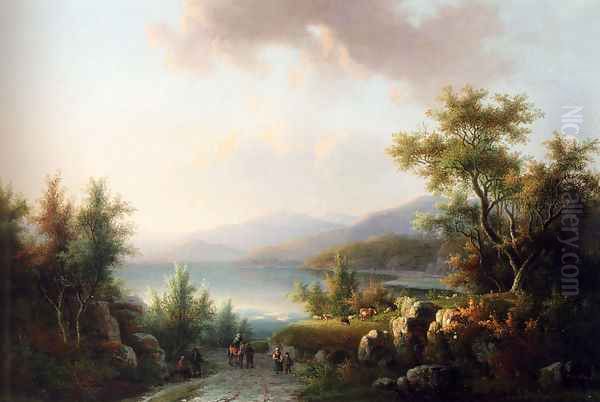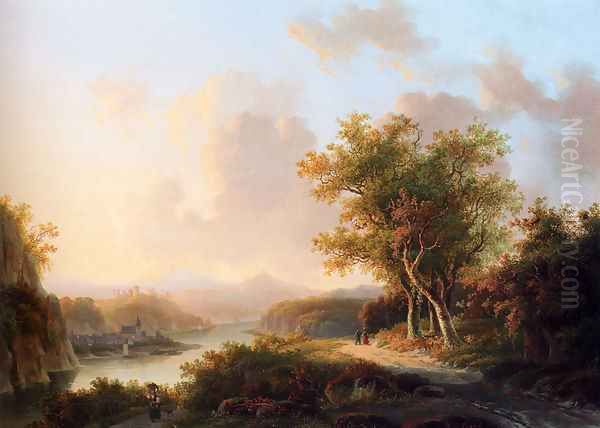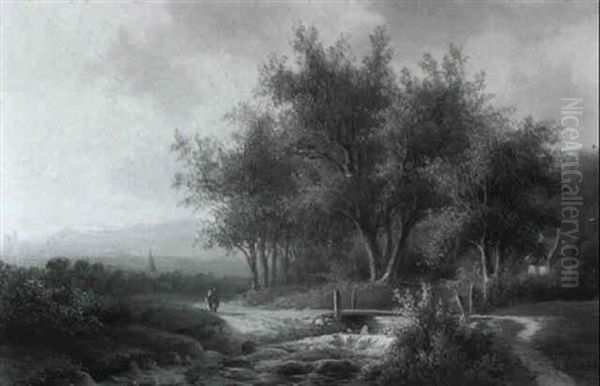Introduction: Unveiling a Dordrecht Artist

Willem de Klerk (1800-1876) stands as a figure within the rich tapestry of 19th-century Dutch art, primarily recognized for his contributions to landscape painting. Born in the historic city of Dordrecht, a place with its own significant artistic heritage, De Klerk dedicated his career to capturing the nuances of the Dutch countryside and the lives of its inhabitants. His lifespan places him in a fascinating period of transition in European art, bridging the gap between Neoclassicism, Romanticism, and the burgeoning Realist movements that would gain prominence later in the century.
While detailed biographical accounts of Willem de Klerk's life remain somewhat scarce compared to some of his more famous contemporaries, his documented works provide valuable insight into his artistic vision and technical skill. He specialized in landscapes, often featuring rural settings, wooded areas, and scenes of everyday life, rendered with a sensitivity characteristic of the Dutch landscape tradition. It is important to distinguish this artist from other notable figures bearing the same surname, particularly the 20th-century South African politician F.W. de Klerk, with whom he shares no connection beyond the name.
Early Life and Artistic Formation in Dordrecht
Willem de Klerk was born in Dordrecht, Netherlands, on November 28, 1800. Dordrecht, situated in the province of South Holland, had been a center for trade and art since the Dutch Golden Age, fostering talents like Aelbert Cuyp and Ferdinand Bol centuries earlier. Growing up in such an environment likely provided De Klerk with early exposure to a strong artistic legacy, particularly in landscape and genre painting, which were hallmarks of Dutch art.
Information regarding his specific artistic training suggests he may have received instruction from P. Hofman and A. van de Kooij. These figures, while perhaps not internationally renowned today, would have been part of the local artistic network providing foundational training in drawing, composition, and painting techniques prevalent in the early 19th century. This education would have grounded him in the principles of observation and representation essential for landscape painting, likely emphasizing careful draughtsmanship and an appreciation for the local environment. The specifics of his apprenticeship or formal schooling beyond these potential tutelages are not extensively documented.
Artistic Style: Rooted in Dutch Tradition

Willem de Klerk's artistic style is firmly situated within the Dutch landscape painting tradition of the 19th century. This era saw artists continuing the legacy of the Golden Age masters while adapting to contemporary sensibilities, often influenced by Romanticism's emphasis on nature and emotion, yet retaining a characteristically Dutch focus on realism and local scenery. De Klerk's work typically embodies a calm, detailed observation of the natural world.
His landscapes often depict serene, well-ordered scenes of the Dutch countryside. He showed a fondness for wooded areas, gentle hills (somewhat atypical for the largely flat Netherlands, perhaps indicating specific locales or a slightly romanticized view), riverbanks, and rural pathways. The inclusion of figures – often peasants, farmers, or travelers – adds a narrative element and sense of scale, portraying a harmonious relationship between humanity and nature. This aligns with a broader European trend in the Biedermeier period, which valued domesticity, simplicity, and the tranquility of rural life.
De Klerk's technique likely involved careful brushwork, attention to detail in rendering foliage, trees, and architectural elements like farmhouses or village churches, and a considered approach to light and atmosphere. While perhaps not as dramatically atmospheric as the later Hague School painters, his works convey a sense of place and time, capturing the specific qualities of the Dutch landscape under varying conditions, such as the soft light of a summer day or the textures of old trees and rustic buildings. His palette was likely naturalistic, reflecting the greens, browns, and blues of the countryside.
Representative Works: Capturing the Dutch Scene
Several documented works offer glimpses into Willem de Klerk's artistic output and thematic concerns. These paintings confirm his focus on landscape and rural life, executed during the middle decades of his career.
One notable example is Hoeft onder oude bomen (Farmstead under Old Trees), dated 1849. The title itself evokes a quintessential Dutch rural scene – a farmhouse nestled amongst mature trees. This subject matter suggests a focus on the established, enduring aspects of country life, emphasizing stability and harmony with nature. The dimensions (57.5 x 74 cm) indicate a moderately sized canvas suitable for capturing a detailed landscape view.

Another significant work is Landvolk op een kerkje in de bos (Country Folk near a Church in the Woods), painted in 1853 and measuring 56.4 x 71.5 cm. A very similarly titled work, Landvolk op een bospad bij een kerkje (Country Folk on a Forest Path near a Church), also dated 1853, likely refers to the same painting or a close variation. These titles highlight De Klerk's interest in integrating human figures within natural settings, often incorporating elements of rural architecture like a village church, suggesting themes of community, faith, and the passage of life within the landscape.
Bebost beekdal met vee en landvolk (Wooded Stream Valley with Cattle and Country Folk), also from 1853, further reinforces these themes. The inclusion of cattle points to the agricultural rhythms of the countryside, while the stream valley setting offers opportunities for depicting varied terrain and the play of light through trees and on water.
Other attributed titles like A wooded hilly landscape and A Rhenish Summer suggest a broader geographical interest, possibly including scenes inspired by travels along the Rhine River, a popular subject for landscape painters attracted to its picturesque castles and rolling hills. These works likely continued his focus on detailed depictions of nature, perhaps with a slightly more expansive or romanticized scope compared to purely local Dutch scenes.
An earlier work, Plantation Mariënbosch (circa 1825), presents an intriguing possibility. While the location isn't immediately clear (Mariënbosch could refer to places in the Netherlands or potentially its colonies), the term "plantation" might hint at a connection to the Dutch West Indies, as suggested by some fragmented sources. If accurate, this would add another dimension to his oeuvre, though landscape painting within the Netherlands remained his primary focus based on the majority of known works.
The Artistic Context: Navigating 19th-Century Dutch Art
Willem de Klerk operated during a period of steady development in Dutch art, following the disruptions of the Napoleonic era. The early 19th century saw a continuation of established traditions, with artists often looking back to the Golden Age for inspiration, particularly in landscape, portraiture, and genre scenes. Romanticism made its influence felt, encouraging a greater emphasis on emotion, individualism, and the power of nature, though often expressed with a certain Dutch restraint.
De Klerk's contemporaries and predecessors in the landscape genre included prominent figures who shaped the field. Barend Cornelis Koekkoek (1803-1862), often hailed as the "Prince of Landscape Painters," achieved international fame for his meticulously detailed and often idealized forest and winter scenes, setting a high standard for technical proficiency. Andreas Schelfhout (1787-1870) was another highly successful landscape artist, particularly renowned for his charming winter scenes featuring skaters, which became immensely popular.

Other notable landscape and genre painters active during or overlapping with De Klerk's career include Wouter Verschuur (1812-1874), celebrated for his depictions of horses, often within stable or landscape settings, and painters focusing on townscapes or church interiors like Johannes Bosboom (1817-1891), who would later become associated with the Hague School but whose earlier work fits within this period's detailed realism.
De Klerk's style, characterized by its detailed observation and tranquil mood, can be seen as part of this broader movement that valued craftsmanship and the faithful representation of the local environment, albeit sometimes infused with a gentle Romantic sensibility. He worked before the major stylistic shifts brought about by the Hague School later in the century.
Bridging to the Hague School and Beyond
While Willem de Klerk adhered to the landscape traditions prevalent in the first half of the 19th century, the artistic landscape in the Netherlands was evolving. His later career would have overlapped with the emergence of artists who would form the nucleus of the Hague School, a movement that gained prominence from the 1860s onwards.
The Hague School artists, including figures like Jozef Israëls (1824-1911), the Maris brothers (Jacob, Matthijs, and Willem), Anton Mauve (1838-1888), Hendrik Willem Mesdag (1831-1915), and Willem Roelofs (1822-1897), moved towards a looser, more atmospheric style. Influenced by French Barbizon School painters like Jean-François Millet and Camille Corot, they sought to capture the mood and light of the Dutch landscape – often its grey skies and watery expanses – rather than focusing solely on meticulous detail. Their subject matter often centered on peasant life, fishing communities, and coastal scenes, depicted with empathy and realism.
Comparing De Klerk's likely style with that of the Hague School highlights the transition occurring in Dutch art. De Klerk represents the earlier, more detailed and perhaps somewhat more composed approach, while the Hague School embraced greater tonalism, looser brushwork, and an emphasis on capturing fleeting atmospheric effects – qualities that paved the way for Dutch Impressionism.
Painters like Johan Barthold Jongkind (1819-1891), though spending much time in France and influencing French Impressionists like Monet, also played a role in this transition with his dynamic sketches and focus on light. Later figures such as George Hendrik Breitner (1857-1923) and Isaac Israëls (1865-1934), associated with Amsterdam Impressionism, pushed Dutch art further towards modernity, often focusing on urban life with bold brushwork. Even Vincent van Gogh (1853-1890), though unique, emerged from this Dutch context, initially influenced by Hague School realism (especially Mauve) before developing his revolutionary Post-Impressionist style. Willem de Klerk's work provides a valuable reference point for understanding the artistic environment from which these later, more famous movements evolved.
Legacy and Conclusion: A Quiet Contribution
Willem de Klerk's legacy is that of a dedicated and skilled practitioner of Dutch landscape painting during the 19th century. While not achieving the fame of Koekkoek or the transformative impact of the Hague School artists, his work contributes to our understanding of the period's artistic production. His paintings, characterized by their detailed rendering of Dutch rural scenes, reflect the prevailing tastes and artistic conventions of his time.
The scarcity of detailed biographical information means that much about his personal life, his interactions within the art world, and his potential participation in exhibitions remains unknown. However, the attributed works serve as tangible evidence of his activity and skill. They depict a world of pastoral tranquility, careful observation of nature, and an appreciation for the enduring rhythms of country life in the Netherlands.
Willem de Klerk occupies a place within the continuum of Dutch landscape art, upholding traditions while working within the specific aesthetic sensibilities of the early to mid-19th century. His paintings offer viewers a window onto the Dutch landscape as he saw it, rendered with care and a quiet dedication to his craft, before the more radical stylistic innovations of the later 19th century took hold. He remains a representative figure of his generation of Dutch artists who found enduring inspiration in their native scenery.